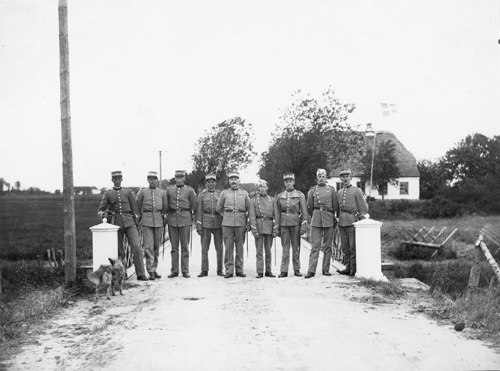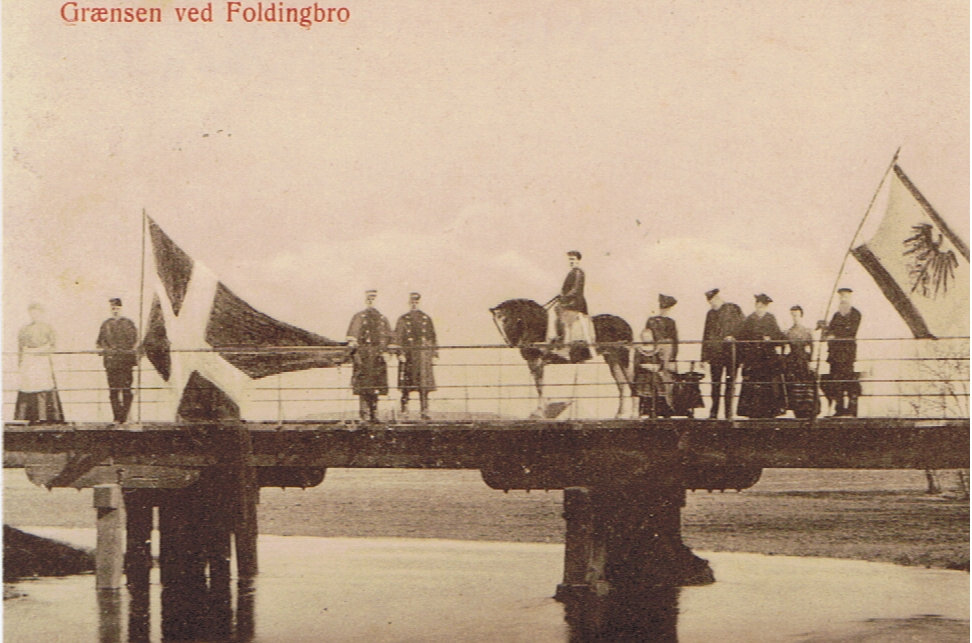The River Kongeå as a national border 1864-1920
At the peace treaty of December 23 1864, the area of Kongeåen from Fårkrog to Villebøl became part of the national border between Denmark and Prussia. This is part of the reason why the river is so well-known in Denmark.
Even before the battle at Dybbøl was fought, the Prussian government announced that in terms of customs, Denmark was to count as being abroad. The old customs border at Kongeåen and Kolding River was restored and customs offices were set up on both sides of the rivers. Prussia assigned the ninth Gerdarmeribrigade in Schleswig to guard the customs border.
New national borders
The national border did not come to follow the old customs border between the Duchy of Schleswig and the Kingdom of Denmark. As a substitute for the royal enclaves in the duchies, Denmark was given Aerø and the eight parishes south of Kolding, the area around Ribe and Kalvslund Herred and a part of Hvidding Herred.
By marking the boundaries of the landscape in the early months of 1865, the boundaries were adjusted. The villages of Kalvslund and Villebøl were now incorporated in Denmark, as opposed to the fact that the kingdom was now cut off at an area south of Brænore to Schleswig. Had this not happened, on a stretch of the road from Kolding to Ribe would have had to go through a Schleswig area.
Three types of customs offices
Customs border posts were set up along Kongeåen in places where it was possible to cross the river. Modelled on the German gendarmerie, the Danish State Border Customs Police Corps was created; a gendarmerie with the task of guarding the border on the Danish side.

The customs border offices were split into three classifications, depending on how busy the crossing was.
1) Border duties collection offices
Here all kinds of customs procedures could be carried out, and all kinds of goods were brought in and out of the country. On the Danish side they were manned by customs officers and gendarmes.
The German equivalent was Nebenzollamt I
2) Border customs checkpoints
Here goods to a limited extent could be brought in and out of the country. On the Danish side they were only manned by customs officers.
The German equivalent was Nebenzollamt II
3) Reporting posts
It was only here that duty free goods could enter and leave the country. On the Danish side they were only manned by gendarmes.
The German equivalent was statistical reporting posts. They did not set up any static reporting posts at Kongeåen.
The classification was not static. It was possible for a border crossing point to change status.
Germany's defeat in World War I led to a change in the boundaries. The people of Schleswig were given the opportunity to decide their own nationality. This was done at a public referendum where Schleswig was divided into three voting zones.
In Northern Schleswig the vote took place on 10 February 1920. The turnout was high and three out of four inhabitants of North Schleswig wanted a Danish affiliation. In Central Schleswig, the vote took place on14 March 1920. Here, the ratio was exactly the opposite. Here, three out of four people wanted a German affiliation. The vote in Schleswig disintegrated.
On 15 June 1920, Denmark took over the regime in North Schleswig. The border was moved to the present frontier, and the border customs offices at Kongeåen were closed down.
(Indsæt kort over området med nedenstående tekst)
Customs offices on the stretch between Fårkrog and Villebøl
Plovstrup
Established in the early summer of 1864 as customs office with the classification as border control checkpoint from January 1, 1865. When the boundaries were changed at Kalvslund, the border control checkpoint was shut again on September 16 1865. Instead, it was changed to a reporting post.
Tobøl
Established in January 1865 as a border control checkpoint. The location was not ideal as it lay 700 metres from the frontier, but it was the only place where it was possible to lease a property. Closed down again in September 1865 in connection with boundary changes at Kalvslund.
Villebøl
Established in the early summer of 1864 as a reporting post, but had its classification changed to border control checkpoint on 1 January 1865. With the inauguration of the new Danish customs building in Kalvslund, the border control checkpoint became superfluous and it was closed on July 1, 1875.
Nielsbygård
Established in 1864 as a reporting post, but there was very little traffic over the river. The reporting post was shut down in 1916 after no import and export of goods had taken place for a number of years.
Foldingbro
Was established as a customs office in the early summer of 1864 with classification as border duties collection office from 1 January 1865. The number of customs operations were very limited in the 1870s and the state's income from the customs office was small. In 1881 Foldingbro was downgraded to being a border customs checkpoint under the jurisdiction of Vamdrup Customs office. On the German side of the border was Zollhebungskontrolle Nebenzollamt I.
Frihedsbroen
Usually reporting posts were established by bridges over the river. However, with the exception of Constitution Day and other large meeting days in Skibelund Krat, the traffic numbers over Frihedsbroen were so poor that the Danish side considered a reporting post unnecessary. On the German side of the border, there was a wooden shed for the gendarmes during patrols and checks on the big meeting days in Skibelund Krat.
Skodborghus
Was established as a reporting post in early summer 1864, but had its classification changed to border customs checkpoint on January 1, 1865. On the German side of the border was Zollkontrolle Nebenzollamt II.
Knag Mølle (Knag Mill)
Was established in 1865 as a reporting post.
Author: Linda Klitmøller, museum curator, Sønderskov Museum


